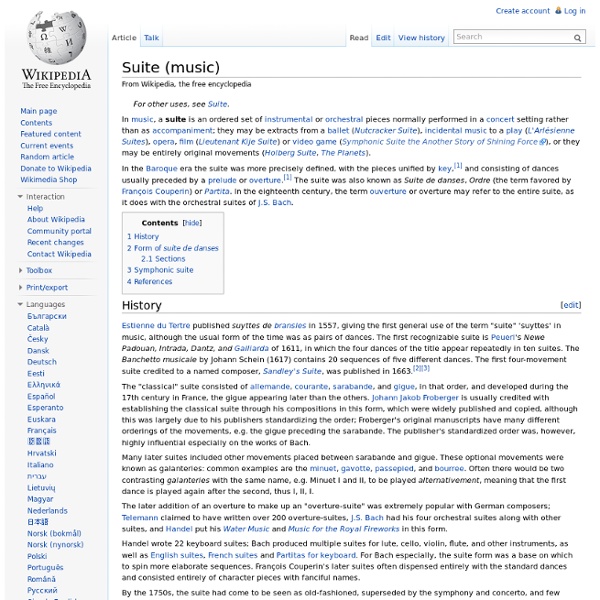Suite (music)
Estienne du Tertre published suyttes de bransles in 1557, giving the first general use of the term "suite" 'suyttes' in music, although the usual form of the time was as pairs of dances. The first recognizable suite is Peuerl's Newe Padouan, Intrada, Dantz, and Galliarda of 1611, in which the four dances of the title appear repeatedly in ten suites. The Banchetto musicale by Johann Schein (1617) contains 20 sequences of five different dances. The first four-movement suite credited to a named composer, Sandley's Suite, was published in 1663.[3][4] The "classical" suite consisted of allemande, courante, sarabande, and gigue, in that order, and developed during the 17th century in France, the gigue appearing later than the others. Many later suites included other movements placed between sarabande and gigue. Brought on by Impressionism, the piano suite was reintroduced by early 20th-century French composers such as Ravel and Debussy.
http://en.wikipedia.org/wiki/Suite_(music)
Suite (music)
In the 17th century many composers such as Bach and Handel wrote suites. They were collections of dances: usually an allemande, a courante, a sarabande and a gigue. Sometimes other dances were included as well, e.g. a minuet, gavotte, passepied or bourree. Sometimes the first movement was not a dance movement but an introduction.
The Baroque Suite
If you have been to many guitar recitals or heard many guitar recordings the chances are you have been exposed to the baroque suite. You may even have had the chance to wonder what it is, why there are some pieces that seem to be called the same in each one, and why there are other groups of pieces that sound pretty similar but are not called "suites". What's going on?
Notes on the Baroque Suite
The principal areas I will cover in this brief discussion of the Baroque Suite are (a) its significance in the history of instrumental music and its origin as stylized dance music, (b) its overall structure and the structure and other characteristics of the individual movements, and (c) some historical and musical facts pertaining to the Suite in C Major for Unaccompanied Violoncello by J. S. Bach. I.
Music History is Thrilling! » Baroque Suite and George Frideric Handel
Terms Suite The Baroque suite was evolved from the Renaissance practise of coupling dances together which provided contrast such as the stately Pavane and lively Galliard.
Related:
Related:



